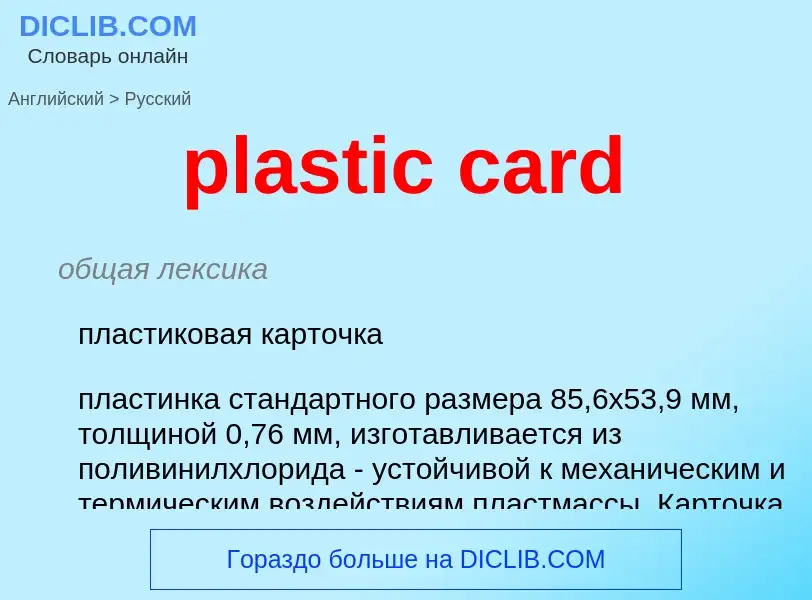Перевод и анализ слов искусственным интеллектом ChatGPT
На этой странице Вы можете получить подробный анализ слова или словосочетания, произведенный с помощью лучшей на сегодняшний день технологии искусственного интеллекта:
- как употребляется слово
- частота употребления
- используется оно чаще в устной или письменной речи
- варианты перевода слова
- примеры употребления (несколько фраз с переводом)
- этимология
plastic card - перевод на русский
общая лексика
пластиковая карточка
пластинка стандартного размера 85,6x53,9 мм, толщиной 0,76 мм, изготавливается из поливинилхлорида - устойчивой к механическим и термическим воздействиям пластмассы. Карточка может содержать фотографию владельца, логотип эмитента, номер счёта и т.д. Данные могут быть выдавлены (эмбоссированы) на поверхности карты рельефным шрифтом. Карточки быть со штриховым кодом, магнитной полосой, с ППЗУ или микропроцессором. Магнитная полоса (по стандарту ISO 7811) располагается на обратной стороне карточки и состоит из трёх дорожек, на двух из которых записывается информация владельца, а на третьей - изменяемая информация
Определение
Википедия
.jpg?width=120)
A debit card, also known as a check card or bank card is a payment card that can be used in place of cash to make purchases. The term plastic card includes the above and as an identity document. These are similar to a credit card, but unlike a credit card, the money for the purchase must be in the cardholder's bank account at the time of a purchase and is immediately transferred directly from that account to the merchant's account to pay for the purchase.
Some debit cards carry a stored value with which a payment is made (prepaid card), but most relay a message to the cardholder's bank to withdraw funds from the cardholder's designated bank account. In some cases, the payment card number is assigned exclusively for use on the Internet and there is no physical card. This is referred to as a virtual card.
In many countries, the use of debit cards has become so widespread they have overtaken checks in volume, or have entirely replaced them; in some instances, debit cards have also largely replaced cash transactions. The development of debit cards, unlike credit cards and charge cards, has generally been country-specific, resulting in a number of different systems around the world, which were often incompatible. Since the mid-2000s, a number of initiatives have allowed debit cards issued in one country to be used in other countries and allowed their use for internet and phone purchases.
Debit cards usually also allow an instant withdrawal of cash, known as a cash advance, acting as an ATM card for this purpose. Merchants may also offer cashback facilities to customers, so that a customer can withdraw cash along with their purchase. There are usually daily limits on the amount of cash that can be withdrawn. Most debit cards are plastic, but there are cards made of metal, and rarely wood.

.jpg?width=200)

